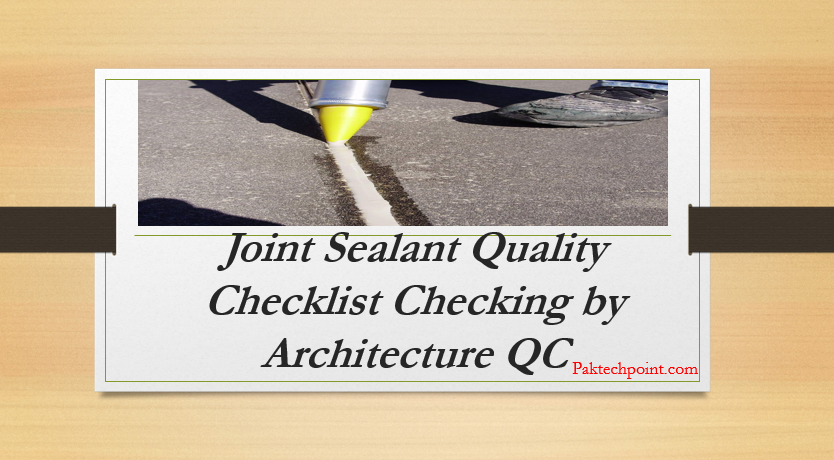This article is about quality checklist points of joint sealants for architectural and construction works.

Joint Sealant Quality Checklist Checking by Architecture QC
Joint-sealant adhesion to joint substrates shall be field-tested as follows:
a. One test shall be performed for each 30 m (100 ft) of joint length for each type of elastomeric sealant and joint substrate.
b. Joint sealants shall be tested by the following hand-pull method:
(i) Knife cuts shall be made from one side of joint to the other, followed by two cuts approximately 50 mm long at sides of joint, and meeting cross cut at one end. A mark shall be placed 25 mm from cross-cut end of 50 mm piece.
(ii) Use fingers to grasp 50 mm piece of sealant between cross-cut end mark 25 mm mark; pull firmly at a 90° angle or more in direction of side cuts while holding a ruler along side of sealant. Pull sealant out of joint to the distance recommended by sealant manufacturer for testing adhesive capability, but not less than that equaling specified maximum movement capability in extension; hold this position for 10 seconds.
(iii) For joints with dissimilar substrates, adhesion to each substrate shall be checked separately by extending cut along one side, checking adhesion to opposite side, and then repeating this procedure for opposite side
c. Joints shall be inspected for complete fill, for absence of voids, and that joint configuration complies with specified requirements. Results shall be recorded in a field adhesion test log.
d. Tested joints shall be inspected and the following reported:
(i) Whether sealants in joints connected to pulled-out portion failed to adhere to joint substrates or tore cohesively. Data on pull distance used to test each type of product and joint substrate shall be included. Results shall be compared to determine if adhesion passes sealant manufacturer’s field-adhesion hand-pull test criteria.
(ii) Whether sealants filled joint cavities and are free from voids .
(iii) Whether sealant dimensions and configurations comply with specified requirements.
e. Test results shall be recorded in a field adhesion test log, and shall include dates when sealants were installed, names of persons who installed sealants, test dates, test locations, whether joints were primed, adhesion results and percent elongations, sealant fill, sealant configuration, and sealant dimensions.
f. Sealants pulled from test area shall be repaired by applying new sealants, following the same procedures used to originally seal joints. It shall be ensured that original sealant surfaces are clean, and new sealant contacts original sealant.
Sealants not evidencing adhesive failure from testing or noncompliance with other indicated requirements, shall be considered satisfactory. Sealants that fail to adhere to joint substrates during testing, or to comply with other requirements, shall be cleaned off. Failed applications shall be retested until test results prove sealants comply with indicated requirements.
Joint Sealant Cleaning
Excess sealants or sealant smears adjacent to joints shall be removed as the work progresses, by methods and with cleaning materials approved in writing by manufacturers of joint sealants and of products in which joints occur.
Joint Sealant Protection
During and after curing period, joint sealants shall be protected from contact with contaminating substances, and from damage resulting from construction operations or other causes. Sealants shall be without deterioration or damage at time of substantial completion. If, despite such protection, damage or deterioration occurs, damaged or deteriorated joint sealants shall be cut out and removed immediately, to ensure that installations with repaired areas are indistinguishable from the original work.